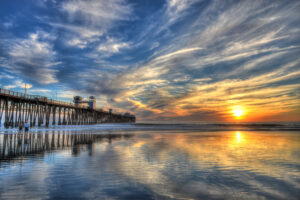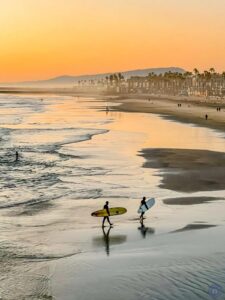Why Does The Humidity Feel Different Next To The Ocean?
Why Does the Humidity Feel Different Next to the Ocean?
So you might be wondering: Why, when living near the Pacific Ocean, does it not feel as humid as it does in the Midwest and East Coast, despite generally high humidities?
Dew Point
 It all has to do with the temperature and the dew point. The dew point is the temperature at which the air reaches 100% humidity, but it can also be used as an informal comfort meter. In coastal areas by the Pacific, summer dew points are generally in the 50s, while in the Midwest and East Coast, they can reach the 60s and even 70s.
It all has to do with the temperature and the dew point. The dew point is the temperature at which the air reaches 100% humidity, but it can also be used as an informal comfort meter. In coastal areas by the Pacific, summer dew points are generally in the 50s, while in the Midwest and East Coast, they can reach the 60s and even 70s.
Low Temperatures
Temperature plays a big role too. Your body doesn't really feel the humidity until the temperature gets over 70 degrees. For example, on a typical summer morning in Seattle, the dew point might be 55 degrees. The humidity will be high in the early morning because the morning low was likely close to 55 degrees, but since it's that cool outside, you don't notice it as much. As the day warms up into the 70s and low 80s, the humidity drops because the temperature moves further away from the dew point, making it feel less humid.
Relative Humidity vs. Absolute Humidity
Relative humidity is the percentage of moisture in the air relative to the maximum amount the air can hold at that temperature. Coastal areas often have higher relative humidity but lower absolute humidity compared to tropical or inland areas. Cooler air can't hold as much

moisture as warm air, so the actual amount of water vapor in the air is lower, making it feel less humid. For example, on the day this was written, the dew point was 76 in Orlando (incredibly oppressive) and 72 in Washington, D.C. Even though Orlando was in the 90s and D.C. was in the mid 80s, they were much closer to their dew points, making it feel much more humid and uncomfortable.
So, an 85-degree day with a 55-degree dew point feels much more comfortable than an 85-degree day with a 65-degree dew point.
Two Other Factors
(1) Humidity makes it feel hotter because it makes it harder for your body to radiate heat. The body cools by sweating, which then evaporates into the air. If there is more moisture in the air, it's harder for sweat to evaporate, making it harder to cool off.
(2) Coastal areas often have a pattern where it's either cool and humid, or hot and dry. Cool, humid breezes come from the ocean, but to get a hot day, winds need to come from the east, pushing back the cool ocean breezes. These east winds come from the desert-like Eastern Washington. As this air sinks down the western slopes of the Cascade Mountains, it gets warmer and drier, making hot days typically very dry—similar to desert heat in Southern California and Arizona.
Microclimates
Coastal areas can have varied microclimates. Areas right on the beach might feel different from areas a bit inland due to differences in exposure to the breeze and temperature variations.
Summary
In summary, it comes down to Temperature, Dew Point and Absolute Humidity. The combination of cooler temperatures, ocean breezes and a lower dew point and absolute humidity levels, all contribute to the perception that it doesn't feel as humid by the Pacific Ocean, even when the relative humidity is high. Additionally, on warmer days, the humidity decreases as the temperature rises, maintaining a comfortable environment.
